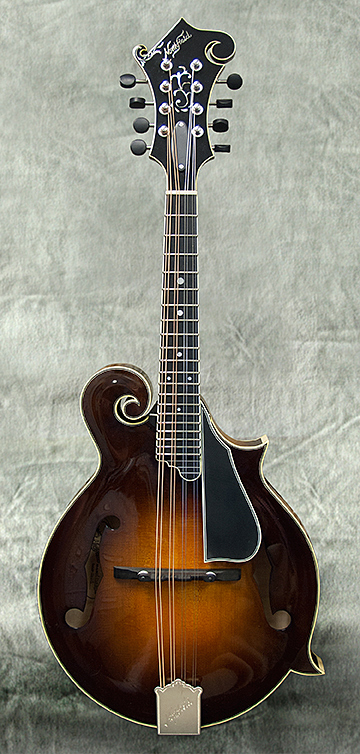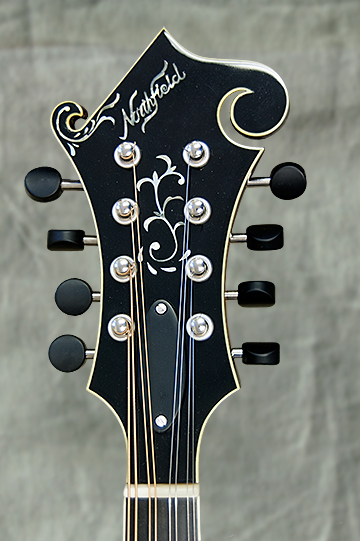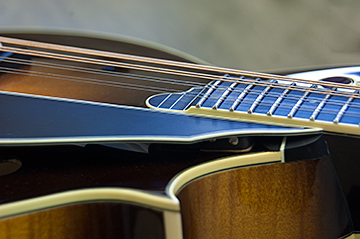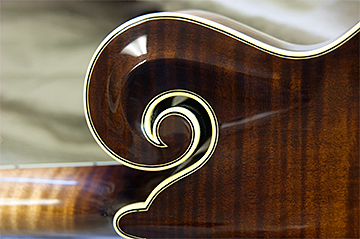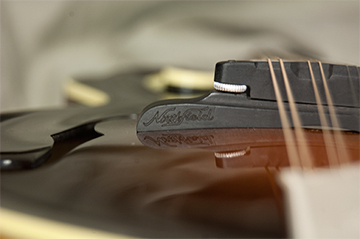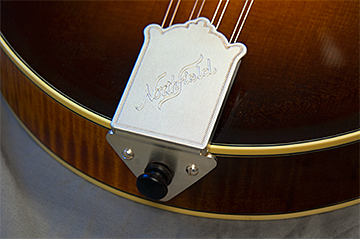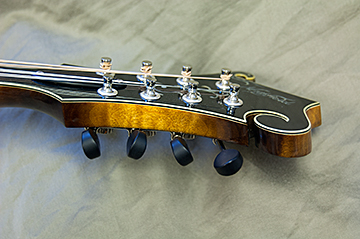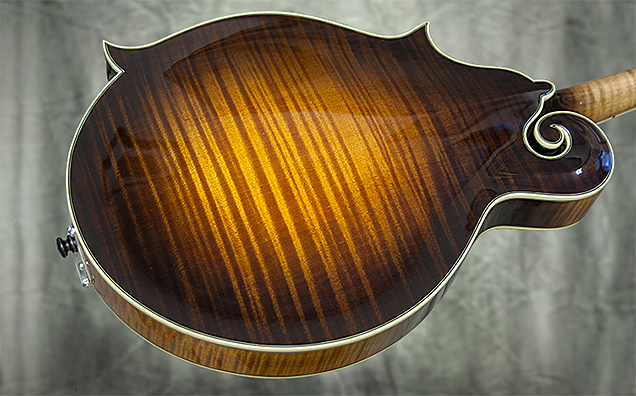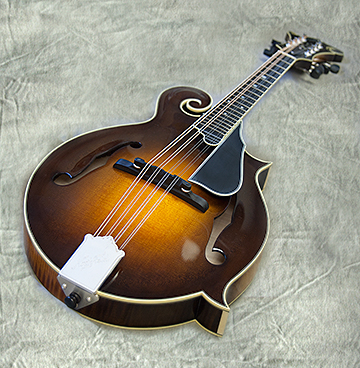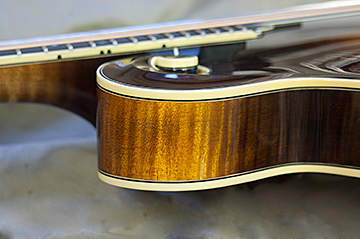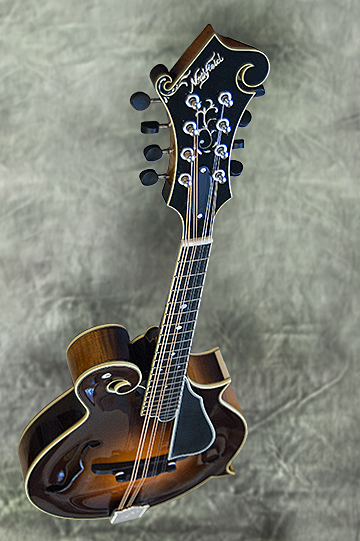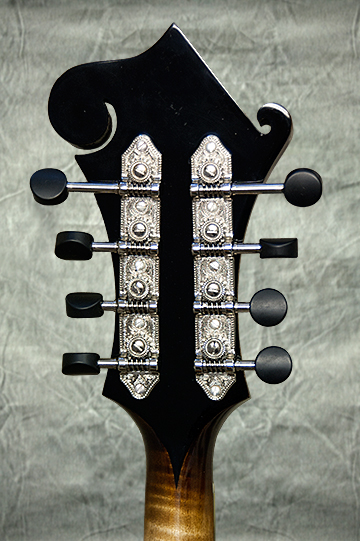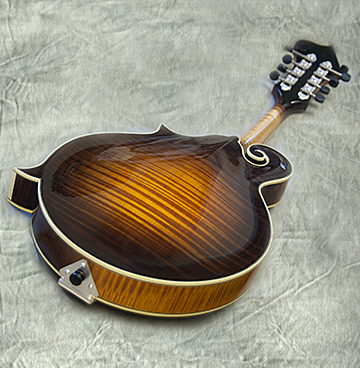2013 Northfield F-5 mandolin
(click on images to see larger versions)
– Northfield NF-F-5M Master Model, ser.# 130215
– top: premium red spruce
– back: premium one-piece flamed red maple
– sides: premium flamed red maple
– neck: premium flamed red maple, rounded-V profile w/ adjustable truss rod
– body bindings: 5-ply white/black/white ivoroid bindings (3-ply construction from the frontal view; sides have a pinstripe across the bottom edge) on top, sides & back
– front headplate: ebony w/ Master Model standard mother of pearl inlay; white/black/white binding
– fingerboard: ebony w/ compound radius
– fingerboard binding: white/black/white ivoroid
– nut: bone
– bridge: adjustable ebony
– saddle: radiused ebony
– tuners: Schaller, silver finish w/ black buttons
– fret markers: mother of pearl dots
– bracing: spruce tone-bars
– frets: nickel-silver
– pickguard: ebony, ‘triple-bound’ white/black/white ivoroid
– tailpiece: silver finish Bill James tailpiece w/ Northfield logo engraved
– finish: spirit varnish
INCLUDED OPTIONS:
– Premium (special stock) woods w/ one piece back option
– wider & thicker ‘Big Mon’ body shape
– larger f-holes
– violin varnish finish on neck
– ‘modern’ setup option: 20 larger frets w/ shortened and scooped extension and three faux frets
DIMENSIONS:
(conversions from metric)
scale length: 13 13/16″
width at nut: 1 3/32″
width at 15th fret: 1 1/2″
saddle spacing (outer G to outer E): 1 1/2″
nut spacing (outer G to outer E): 63/64″
fretboard radius: 5.7″(nut); 7.7″(20th fret)
weight: 2.2 lbs.
width: 10 1/16″
depth at tailblock: 1 3/4″
body length: 13″
length tail to end of scroll: 13 7/8″
total length: 27 1/2″
A Player’s Review, 4/3/14:
Choosing the Northfield:
The complete Northfield story can be found here at their website, but briefly, primary construction of the instruments is the responsibility of an international group of master craftsmen: Kosuke Kyomori (Japan), Jidou Qin (China) and Dianhong Yin (China) led by team leader Xi Sheng Zhang (China) at Northfield’s shop in Qingdao, China, home of Tsingtao beer(!). Instruments are then sent to Derek Smith and company head Adrian Bagale at Northfield’s shop in Michigan for testing and set-up/final detailing. These are professional-grade instruments, and while not cheap, they compare favorably with some of the world’s best-known small-shop makes costing considerably more.
In September of 2013, I went to IBMA (the annual meeting of the International Bluegrass Music Association) in Raleigh, NC, and spent six hours in the exhibit hall one day playing F-5 mandolins: three vintage Loars, several each of Ellis, Nugget, Red Diamond, Randy Wood, Pava, Grady, Gibson, Weber, Givens, Collings, Sorensen, & more, ignoring their price tags and simply searching for one that had my own ‘ideal mandolin sound.’ I was able to compare a bunch of great instruments, with different sonic signatures, all in one room. I could play a few, then, with the sound fresh in my ears, walk across the room and play a few others, over and over, as many times as I wanted. It was an unprecedented opportunity to really zero in on the mandolin sound I’ve been searching for. I narrowed things down to a handful of instruments, but the one I kept coming back to, and eventually bought, was the Northfield top-of-the-line Master Model ‘Big Mon’, you see here. It bears serial number 130215, signifying Northfield’s 215th instrument, completed in 2013. I thought it to be the best of the bunch that Northfield was displaying and, except for a deluxe inlay and custom pickguard, it featured all of Northfield’s premium upgrades. I played quite a few great high-end mandolins that day, and frankly, there were some that sounded a bit better to me than the Northfield, but those had price tags far beyond my means. In looks, craftsmanship and especially sound, the Northfield really held its own pretty darn well. So I took it home. That was six months ago. I’ve been playing it constantly ever since, and now have a pretty good handle on its personality, so it’s time to give it a sober, critical review.
Playing an instrument is a complex sensory experience involving Sight, Sound and Touch, and here are my thoughts regarding each of these dimensions for this mandolin.
SIGHT
This mandolin is Northfield’s ‘Big Mon’ model, with a body that is slightly wider and deeper than a standard F-5’s dimensions, but visually, it doesn’t look noticeably bigger. The sunburst transitions smoothly from a dark brown to a dark honey color and the varnish is even and glossy, even in the joints where finish can sometimes accumulate. The woods are all select master-grade, with straight, even grain on the red spruce top and highly-figured red maple on the neck, back and sides. The joinery is about as good as it gets, as the close-up photos above illustrate. A few nice details: the small leather pad on the bottom of the pickguard mount that keeps it from marring the top’s finish (see 4th photo from top); the angle of the flame on the back matches that of the neck; the saddle is radiused to match the fingerboard and all edges are rounded, which is appreciated if one rests the heel of the right hand lightly on the saddle as I sometimes do. Fingerboard and headplate inlays are reasonably tight with little visible filler. The slim pickguard is functional but minimal, and covers only the top of the treble-side f-hole. The only less-than-top-quality feature is the truss rod cover, which appears to be a matte-finish black plastic, but this can be easily replaced with a higher grade material.
TOUCH
Most of this category addresses how it feels to play it, but there are some basic tactile impressions as well.
At 2.2 pounds the Northfield is a little lighter than my Holst, and feels pretty typical for a truss-rod equipped mandolin. Like most such mandolins, the balance point is weighted a bit toward the neck, but it doesn’t feel particularly neck-heavy, especially since I fitted it with a Tone-Gard soon after its arrival, adding a bit more weight to the body. The ‘Big Mon’ body shape also doesn’t feel noticeably wider or thicker than a typical F-5. When seated, with the left knee raised in playing position, the treble-side point holds the instrument at the proper angle for good technique. The rounded-V neck and fingerboard of this mandolin feel like they were made for me. The ‘violin finish’ on the neck is smooth and silky, with just enough gloss removed to make changing hand positions fluid and efficient, and it’s equipped with the larger ‘modern’ frets that I prefer. I like a substantial radius in a fingerboard, and this one’s compound radius (5.7″ at the nut, graduated to 7.7″ at the 20th fret) is ideal for my hands. I mostly play solo, with a light touch, so I’ve set the action quite low, lower than I’d have it if I were doing a lot of rhythm playing in an ensemble. I’ve set only a slight relief to the neck, the frets are even, and everything feels as easy to finger as I could ask for, everywhere on the fingerboard. The only playability feature that was not optimal for me was the string spacing at the nut, and after struggling with it for several months, I ordered some bone nut blanks from Stewart-McDonald and made a new nut that increased the spacing 1/32″ from outer G to outer E, and moved the strings of the A and E pairs 1/64″ closer together. It doesn’t sound like much, but it’s a difference I can really feel and is more suited to my style, technique and the types of music I’m currently working on.
SOUND
Balance
This instrument is extremely well-balanced, with an even, midrange-y voice typical of many Gibsons I’ve played. When the strings are played individually, notes are strong and solid anywhere on the fretboard. When strummed, there is good note separation and all strings can be heard distinctly.
Sustain
I measure sustain by using a stopwatch, hitting a firm strum, then leaning in close until the sound fades to silence. I do this 4 or 5 times, then average the times. I’m usually within a second each time. My 1980 Sobell cittern is my benchmark instrument for a long sustain at a ridiculous 42 seconds. My three custom guitars all have a sustain between 30-35 seconds. I expect a mandolin to have a sustain somewhat shorter than a guitar, so I consider this one’s 20-22 second sustain to be better than average, and very good-to-excellent for my purposes. The G and D tones have the longest decay, with the harmonic partials falling away after about 10-12 seconds.
Volume & Projection
From a player’s vantage point, this mandolin’s volume is excellent, with all the dynamic range I could ask for. Since I generally play solo, I don’t often get a chance to evaluate volume & projection from the listener’s perspective, but on those occasions when I’ve listened to it played by others, volume & projection seem to be very good-to-excellent. I’ve not had a chance to evaluate it for volume and ‘cut’ in a jam situation, but I expect it would do quite well.
Response
This quality describes both the energy required to move the strings (its sensitivity) as well as the speed at which it responds to that energy (its ‘pop’). I’ve found red spruce tops to require a bit more energy to move, but this one really responds quite easily. To my ear, it’s easy for a mandolin to sound a bit harsh, especially when played aggressively, so I favor a lighter touch that can bring out an instrument’s warmer qualities. A light touch requires a very responsive instrument, however, one that can display nuance and sweetness throughout a respectable dynamic range. The sensitivity of this Northfield is excellent, and rewards a light touch beautifully. Its ‘pop’ is also very good-to-excellent on all strings.
Depth
The depth or spaciousness of the sound is what gives it dimension and presence. I think of it as how far down in the body the sound seems to come from and how completely the sound chamber is pushing out sound. I’ve found that f-hole designs in general have less depth than an oval-hole, with the sound seeming to jump off the face of the instrument rather than coming from deep in the body. Having said that, this mandolin seems to have a bit more depth than most f-holes, especially noticeable on the low end, which adds some overall warmth.
Resonance
The character of the harmonic frequencies as an indicator of how completely an instrument seems to be vibrating is what many call resonance. However, I make a distinction for it here as a measure of fullness in the sound I can both hear AND feel. Like most f-hole mandolins I’ve played, the crisp, compressed quality of its timbre that many call a ‘focused’ sound might create an inital impression of tightness or restraint in the instrument’s resonance. The fact that the F-5 design is meant to strongly project sound away from the mandolin, perhaps leaving an impression that it’s louder from a distance than it seems to the player, might increase the perception that its complete resonance is being compromised. However, while this mandolin exhibits an F5’s characteristic focus to a certain degree, it also has an open, airy quality that dispels the impression of tightness and sounds and feels as if all parts of the instrument were vibrating fully to create its unique voice. It is this quality that I find to be one of this mandolin’s greatest strengths and most distinctive features. I notice it anew every time I play it, and it never fails to captivate my ear.
Overtones
Overtones are the harmonic frequencies complementing the fundamental tones. Some limit the definition to partials of the plucked strings, but I use it to encompass sympathetic vibrations in the unplucked strings as well. As luthier Alan Carruth puts it, “An acoustic (instrument) acts as a complex filter, reducing the output of some frequencies and enhancing others relative to the mix the plucked string produces. Every (instrument) is a bit different in this regard.” An instrument that generates a lot of overtones is said to be ‘complex’ or ‘sparkling,’ while one with fewer overtones is said to be ‘dry.’ These complementary frequencies add tonal color and give the sound personality. How prominently one likes to hear overtones is a matter of taste, and many bluegrass players may prefer a dry sound with less overtones. For solo playing I prefer prominent overtones, and this mandolin’s strong sustain, response and resonance highlight them well, creating a series of rich, ringing harmonic frequencies coloring the fundamental tones as the melody line hits various thirds, fifths and octaves of adjacent strings.
Timbre/Tone
If the sustain and overtones give the sound ‘personality,’ timbre describes the quality of that personality, combining the fundamentals, overtones and all other resonant frequencies generated by both the vibrating strings and the vibrating wood to create a particular instrument’s unique voice. It’s what makes a middle ‘C’ played on a clarinet sound different from a middle ‘C’ played on a trumpet. It is this ‘quality of personality’ I believe most folks refer to when they speak generally about an instrument’s ‘tone,’ and this is a subjective area where metaphor becomes the standard currency. The Northfield’s timbre is quite pleasing, with a nice ‘woodiness’ (think of the timbre of a marimba bar or wooden bell struck by a wooden mallet) throughout its range, but its typical F5 focused quality can sometimes create a slight, metallic harshness (I call it a ‘crunchy’ sound), common to most f-holed mandolins I’ve played, when a note is not fretted cleanly, especially in the trebles – yet another reason to concentrate on good technique! The overtones give the trebles some nice sparkle without sacrificing clarity, and overall, the timbre is smooth and fairly warm-sounding, especially when I compare it to other f-holed instruments.
SUMMARY
In general, the mandolin timbre I find most satisfying has good depth, especially on the low end, with clear, bell-like trebles and a smooth, creamy quality with no hint of harshness throughout its dynamic range. In my experience, such a timbre can most consistently be found in an oval-hole design. However, the oval-hole’s limitations in volume, projection, sustain, etc. are often areas in which the f-hole design excels. On the other hand, the characteristic ‘focused’ quality of the F-5’s timbre can sound, in a bright-toned instrument, a bit brittle, and in a dark-toned instrument, a bit dull and dry. So my quest is to find a timbre that strikes the right balance between the depth and smoothness my ear craves and the focus that f-holes are known for, with just a bit more sparkle (overtones) than usual in the trebles. The Northfield gets me a long way toward that goal. Since I brought it home from IBMA, I’ve continued to expand my knowledge of what an f-hole mandolin can sound like by comparing it to other fine instruments that have come my way (Brock, Mowry, Ellis, Gibson, Randy Wood, etc.) and whatever else I may learn, I usually also come away with a renewed understanding and appreciation for the Northfield. There may be an F5 out there with that magic, Exceptional sound that will stop me in my tracks, and I will certainly continue to look for it. It is, after all, the Quest for Excalibur, the Ultimate Weapon, but should I never find it, as the mandolin and I continue to ‘open up’ together, this Northfield continues to be a delightful and satisfying companion.

